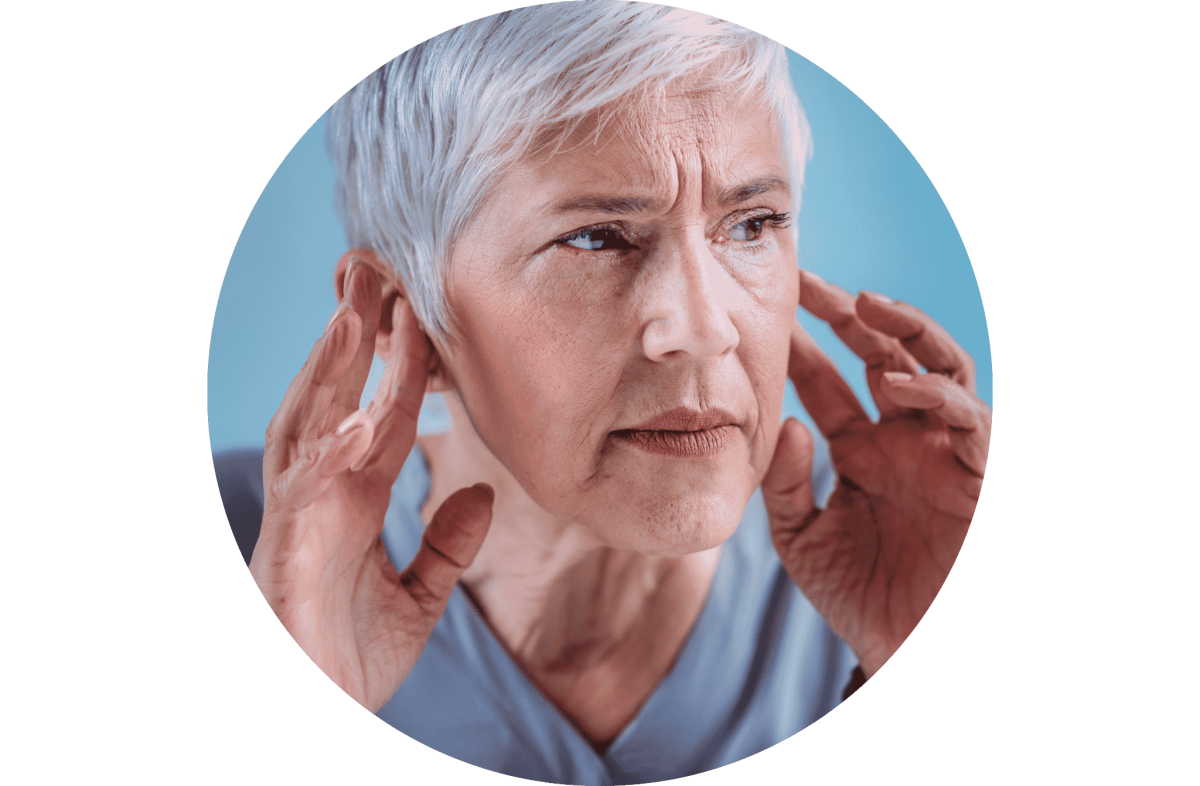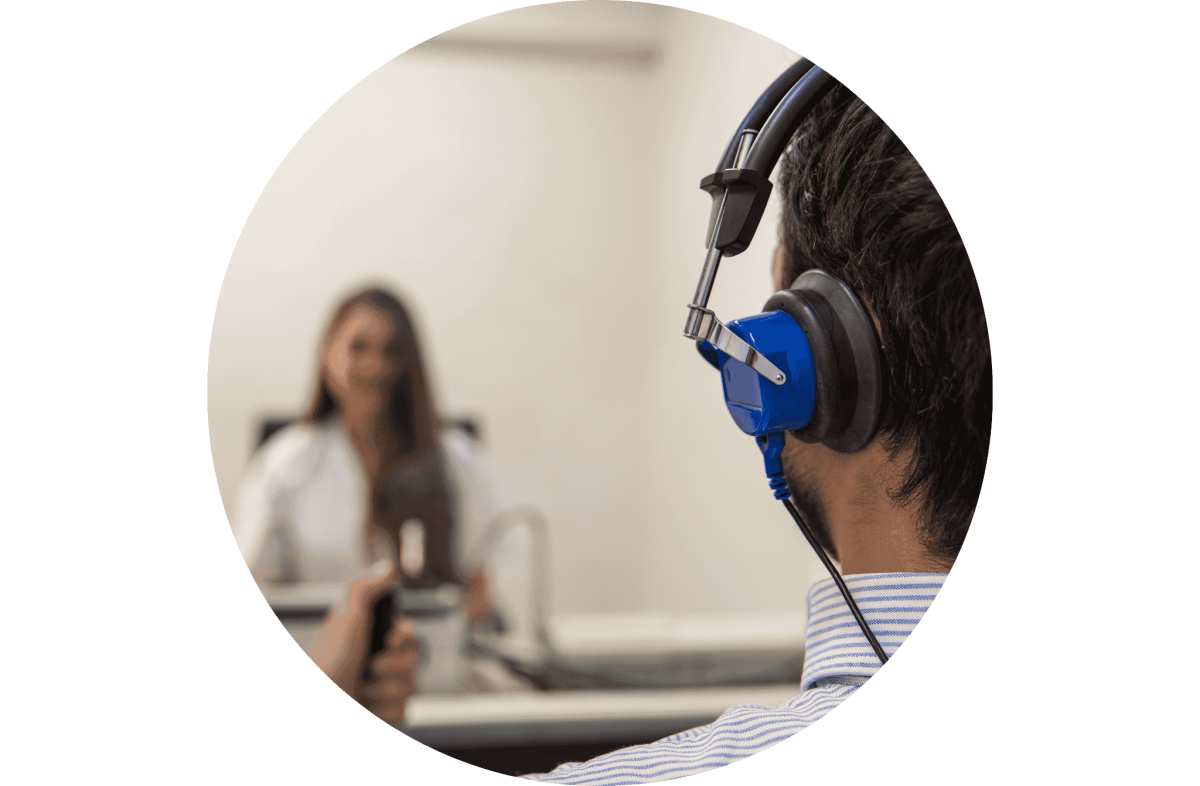Assists in the detection of fluid in the middle ear, perforation of the eardrum, or mobility problems of the eardrum.
Tympanometry pushes air pressure into the ear canal, making the eardrum move back and forth. The test measures the mobility of the eardrum. Graphs are created, called Tympanograms. These can reveal a stiff eardrum, a hole in the eardrum, or an eardrum that moves too much.
Audiology Services in Delhi
Audiology
Audiology At ENT Delhi

Pure Tone Audiometry (PTA)
Pure tone audiometry is a hearing test used to determine the presence or
absence of hearing loss and also the type and severity of hearing loss. This test involves placing earphones on both ears and pressing a button or raising your hand when you hear a sound.

Speech Audiometry
Speech audiometry is a test using words to determine how softly words can be heard and how clearly words are understood. You will listen to a list of words and repeat them back to the Audiologist. The words lists are presented at different intensities. The results of word understanding are measured by a percentage score. The main purpose of this test is to check the ability to recognise speech.

Tympanometry
What Is Audiology
Do I need Audiology Test?
Audiology is derived from a Latin word called ‘audīre’ which means “to hear”. It is the branch of science that studies hearing, balance, and related disorders including Tinnitus.
Audiology aims to determine whether someone can hear within the normal range, and if not, which portions of hearing (high, middle, or low frequencies) are affected and to what degree. Audiologists are experts in the management of the auditory and balance systems.
There are a number of tests available to determine the degree and type of hearing loss e.g. PTA, Impedance, OAE, BERA, ASSR etc. Once the diagnosis is confirmed the patient is referred to the ENT Specialist for further management.
It is important to remember that these tests are ‘Non Invasive’ and do not cause any pain!
Frequently Asked Questions
The Centre has an advanced Vestibular testing Lab to evaluate patients of Vertigo/ Giddiness/ Balance Disorders
When your hearing is working normally, information is being passed through each section of the ear to your brain. Your brain receives these messages and you will hear and understand the sound.
Anatomy of your ear
There are three parts of the ear anatomy, the outer ear, the middle ear and the inner ear.
The outer ear consists of the pinna, ear canal and eardrum
The middle ear starts with the ear drum and includes the middle ear chamber along with the three ossicles (Malleus, Incus, Stapes).
The Inner ear consists of the Cochlea (for hearing sound) and the Vestibule (for maintaining balance).
The Outer Ear
Sound travels in waves through a narrow passageway called the ear canal to the ear drum. The outer ear (pinna) ‘catches’ sound waves and directs them through the ear canal to the protected middle ear. These incoming sound waves cause the ear drum to vibrate.
The Middle Ear
These vibrations cause the ossicles, a tiny chain of bones (malleus, incus, stapes), to move in the middle ear. The sound is amplified and transmitted to the Inner Ear.
The middle ear is connected to the back of the nose and throat by the Eustachian tube. This means that when you yawn or swallow, the Eustachian tube can open to equalise the pressure on both sides the eardrum and prevent the membrane from being stretched or under pressure..
When you get a cold/flu like symptoms the Eustachian tube can become blocked with mucus which can cause a build-up of pressure and temporary hearing impairment as a result.
The Inner ear
The last bone in this process apostrophe on the membrane window of the spiral-shaped cochlea, which encourages the fluids in the cochlea to move and in doing so stimulate tiny hair cells on the inner wall of the cochlea. There are over 15,000 of these hairs, and stimulating them to move triggers electrical nerve impulses that are taken to the brain via the auditory nerve. From here, it’s up to your brain to decipher those impulses as recognisable sounds.
Changes in your hearing
Hearing loss is a common problem and can affect anyone. As we get older, naturally our hearing changes. This can be a gradual process- you may not even know that you’ve lost some of your hearing or recognise the symptoms.
Hearing loss commonly comes from changes in the inner part of your ear, but can also arise from changes in the middle ear or along the nerve pathways. Understanding how your hearing works and the causes of hearing loss can help you protect your hearing for the future or address ways of correcting the hearing impairment. In some cases hearing aids could be an option to consider.
Balance and your ears
Aside from hearing, the ears do also have another important function: balance. Within the inner ear are three ringed canals containing fluid. The Posterior, Lateral and Superior canals operate on different planes (think of measuring a box: it has length, depth and width) and the way the fluid in these canals moves around is how the brain helps to establish balance. The continued movement of these fluids is why people feel dizzy after spinning around, before feeling back to normal once the fluid settles again. Ear infections and medical conditions which reach the ear can also therefore affect balance as well as hearing.
We depend upon our hearing to interpret the world around us. Through hearing clearly we can communicate and interact with our friends and family or with enjoy our favourite hobbies and interests.
When your hearing starts to deteriorate – which can happen gradually or suddenly- it can impact your life and the way you interact with others.
Sounds around you can become muffled and unclear putting pressure on your brain to find ways to accommodate changes in your hearing to enable you to continue interpreting the world around you e.g. lip reading, body language. You struggle to hear.
As per some statistics around 63 million people suffer from hearing loss in India .
1 in 12 people in India are likely to be suffering from some degree of hearing loss.
The first signs of hearing loss can be subtle and emerge slowly, or can be significant and come about suddenly. Being aware of the early signs of hearing loss can help identify any problems you may be experiencing.
There are different types of hearing loss with differing degrees of severity, but you may have a hearing loss even if you experience one or more of the below hearing loss signs. If you’re concerned about your hearing, our expert can advise how they can help, where you can go for support if a referral is required and answer any questions you may have, assuring you of our ability to provide the information you need to take the next step..
Early Signs are–
- You can hear people speaking but you have difficulty understanding what they are saying
- You frequently have to ask people to repeat what they have said
- You have difficulty working out where sounds are coming from (Localisation)
- You understand more of what is being said if you are looking at the person speaking to you
- Friends and family have noticed that you have the TV or radio turned up too high
- You cannot hear clearly with lots of background noise E.g Noisy places like a busy restaurant
- You strain to hear at a distance such as in a theatre or any religious place.
- You complain that others are mumbling
- You feel left out of conversations
- You do not hear the doorbell or telephone
- You miss jokes because you didn’t hear all of what was being said
- You have difficulty hearing children’s voices
- You can no longer hear soft sounds such as birds singing
- You have a history of exposure to loud noise, e.g. working in the construction industry
- You need to ask colleagues about the details of a meeting or presentation you attended
First signs of hearing loss usually include difficulty following conversations amid background noise, trouble understanding higher-pitched voices (such as children’s/women’s voices) and needing to turn the volume up on the TV.
The world around us is full of a wide variety of sounds. These sounds can be become harmful when you are exposed to loud noises, even for a short amount of time or when they are loud and long lasting e.g. a music concert, listening to you iPod/MP3 player persistently at a loud volume or working on a building site. These sounds can damage sensitive structures in the inner ear which can cause noise-induced hearing loss.
High frequency hearing loss is one of the most widespread form of hearing deterioration as it is normally a result of excessive noise exposure or the natural ageing process; both ears are usually affected.
There are two main types of hearing loss, conductive and sensorineural. You can read more on these types of hearing loss below.
Conductive hearing loss
Conductive hearing loss occurs when sound waves cannot reach the inner ear. There could be a number of different reasons. Some of the causes include:
- A build-up of earwax in the outer ear stopping sound getting to the ear drum
- Ear infection or inflammation in the outer ear (Otitis Externa) or middle ear (Otitis Media)
- A build-up of fluid in the middle ear (Glue ear)
- Perforated eardrum
- A foreign body
- Abnormal bone growth in the middle ear (Otosclerosis)
- Fixed or absent Middle ear Ossicles
Conductive Deafness can often be treated with simple procedures (wax removal), medication (treat middle ear infection) or surgery (repair of the ear drum, removal of fluid from the middle ear, replacing the ossicles etc)
Sensorineural hearing loss
This is the most common form of hearing loss and occurs when the tiny hair cells in the inner ear are damaged or when the hearing pathways to the inner ear become damaged.
Sensorineural hearing loss can be caused by a wide range of conditions but most commonly by the natural ageing process which accounts for around 90% of this type of hearing loss. It affects 1 in 7 over the age of 65 (http://www.hearinglink.org/what-is-sensorineural-hearing-loss). There are variety of different hearing aid solutions that can help make hearing the things around just a bit clearer.
Some of the causes are:
- Age – gradual deterioration in hearing across both ears in high pitched sounds
- Traumatic exposure to loud noise – This could be permanent or temporary. This may be a sudden very loud sound or repeated exposure to high level sounds
- Head injury – This can cause trauma to the cochlea and nerves in the ear
- Viral and bacterial infections of the inner ear and auditory nerve
- Some drug treatments
- Family history
Noise-induced hearing loss
Everyday we experience sounds around us from the television, traffic, household appliances or a phone ringing. These sounds are all at safe levels that do not affect our hearing.
Sounds become harmful to our ears when they are too loud, even if it’s only for a short time or when the sound is loud for a long period of time. The effects of such prolonged loud noise over time can result in a deterioration in your hearing.
Hearing aids can help improve your hearing so you can continue to enjoy the sounds around you.
Noise induced hearing loss can be brought on suddenly or over a period of time. It may be temporary or permanent and could affect both ears or just one ear. Even if you don’t think your hearing has been affected by the exposure, it could change in the future. Having an effortless conversation with friends and family face to face or over the phone could become more challenging as you struggle to understand clearly what people are saying. With background noise as well, this can become frustrating – not being able to hear clearly what is being said.
If you work in a noisy environment, such as a nightclub, construction site or factory we would recommend protecting your hearing. Employers are required to provide hearing protection if the noise in your workplace exceeds 85 decibels.
Regularly listening to music at a high volume with headphones can damage your hearing. Very loud noises such as explosions can also affect your hearing temporarily or permanently, which is known as acoustic trauma.
Protecting your hearing for the future is important. Being aware of the causes of hearing loss will help protect you and your friends and family for the future.
High Frequency hearing Loss
High frequency hearing loss can affect anyone at any age. It usually means that you have a reduced hearing sensitivity predominantly at frequencies above 2000 Hz.
A high frequency hearing loss results in difficulty in understanding speech especially in the presence of background noise and will usually worsen over time. There is a wide variety of hearing solutions with leading innovative technologies available to assist with high frequency hearing loss.
Age-related hearing loss
Age-related hearing loss is the single most common cause for partial loss of hearing, also known as Presbyacusis.
Most people begin to lose a small amount of their hearing ability in their 40’s and can gradually get worse as you get older: by the age of 80, a large majority of people have some form of hearing loss.
Presbyacusis occurs when the sensitive hair cells in the inner ear gradually become damaged or die as you get older, and do not regenerate.
As we go about our day to day lives we are bombarded with a steady stream of sounds at different levels and sometimes these sounds are so loud that they can damage your hearing. The key to keeping your hearing healthy is understanding just how much damage that loud sounds can cause.
Sudden sounds like fireworks or a shotgun are loud noises that can easily damage your hearing. Repeated exposure to sounds over a longer period of time like machinery, loud music, festivals or concerts can gradually take its toll on your hearing without you even noticing. This type of damage is likely to be permanent.
There are many work environments that require the use of hearing protection. Musicians need protection for their ears, as do gunners in the Army, Armoured Car and Tank personnel, aircraft maintenance Engineers who work in the hangar, Drill operators etc.
You may or may not know that regular exposure to sounds at 85dB or above can affect your hearing on a more permanent basis. It’s important to know that you can protect your hearing with simple but effective preventive measures. If you’re concerned about your hearing, our team of expert hearing specialists are available to answer any questions you may have about protecting your hearing for the future.
What can I do to protect my hearing?
The important thing to remember is that you can take preventative measures to protect your hearing.
- Reducing the time you are exposed to high noise levels.
- Turn the volume down on MP3 players or other personal music devices and use sound excluding headphone or ear buds
- Avoid using too many noisy appliances on at the same time at home
- When purchasing new products check the dB, the lesser the better
- Move further away from any source of loud sounds
- Wear hearing protection when working with noisy equipment.
Researchers have found that antioxidants, such as vitamins C and E and betacarotene, supplements that contain magnesium can help to minimise noise-induced hearing loss. Whether these really help or not, the very best advice is never to do anything that could put your precious sense of hearing at risk of permanent damage.
The otoacoustic emissions (OAE) test that check the outer hair cell function of the inner ear(cochlea) to estimate hearing sensitivity. It is now used as a new born screening test.
The ABR test is used to test the functional status of the auditory neural pathway (how sounds travel to the brain) and to assess hearing when behavioural testing cannot be performed due to age, cooperation, or developmental level.
Uses
– As a screening procedure for newborns who are at risk for hearing loss.
– As a diagnostic tool to identify infants and small children with a hearing loss.
– To estimate hearing levels in difficult to test patients, i.e., mentally retarded, autistic, developmentally delayed.
Daily OPD
Years of Experience
Happy Patients
Google Reviews Rating
Address
D 3/14, Ground Floor
Vasant Vihar
New Delhi 110 057
Mobile: +91 98711 50032
Hour of Operation
Monday To Saturday
Morning Timing
09:30 AM to 11:30 AM
Evening Timings
4:30 PM to 7:00 PM
Thursday Morning Clinic Is Closed
Thursday Evening
4:30 PM to 7:00 PM
Let's Get In Touch. Contact us.
Get Connected

Get In Touch
Subscribe For Health Updates


